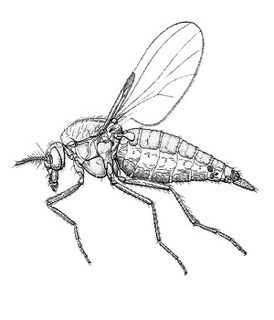
Sandfly is a colloquial name for any species or genus of flying, biting, blood-sucking dipteran (fly) encountered in sandy areas. In the United States, sandfly may refer to certain horse flies that are also known as "greenheads", or to members of the family Ceratopogonidae. Outside the United States, sandfly may refer to members of the subfamily Phlebotominae within the Psychodidae. Biting midges (Ceratopogonidae) are sometimes called sandflies or no-see-ums. New Zealand sandflies are in the genus Austrosimulium, a type of black fly.

Leptoconops torrens is a species of small biting flies in the no-see-um family Ceratopogonidae. They were first mentioned in writing by Charles Henry Tyler Townsend in 1893. The name Leptoconops carteri is a junior synonym of L. torrens. They are prevalent in the southwestern and southeastern areas of the United States. In early stages of life, L. torrens flies dwell in soil, then emerge to feed and breed as fully developed adults.

Ceratopogonidae is a family of flies commonly known as no-see-ums, or biting midges, generally 1–3 mm in length. The family includes more than 5,000 species, distributed worldwide, apart from the Antarctic and the Arctic.
Simulium buissoni, commonly referred to as the black nono or no-no noir des rivières, is a midge species in the genus Simulium found on Nuku Hiva and Eiao, Marquesas archipelago in Polynesia.

Leptoconops is a midge genus in the family Ceratopogonidae. It has a mostly tropical or subtropical distribution worldwide, but some species occur as far north as Moscow region in Russia and the Yukon Territory in Canada.
L. albiventris may refer to:
Leptoconops zherikhini is an extinct species of biting midges belonging to the family Ceratopogonidae. This species was described from fossilized remains preserved in Lower Cretaceous amber from Álava, Spain. These fossils represents the earliest known occurrence of extant genus Leptoconops.

Leptoconops nosopheris is an extinct species of biting midges belonging to the family Ceratopogonidae. This species was described from fossilized remains preserved in Burmese amber from the Early Cretaceous. The amber containing the fossil was mined in the Hukawng Valley, in Kachin State, Myanmar
Leptoconops longicauda is a species of biting midges belonging to the family Ceratopogonidae. This species occurs in the Wudang Mountains, Hubei province, China.
Leptoconops gravesi is an extinct species of biting midge belonging to the family Ceratopogonidae. This species was described from fossilized remains preserved in Late Cretaceous amber from Vendée, France. The piece of amber containing the holotype specimen also preserved a scelionine wasp and an earwig nymph.
Leptoconops amplificatus is an extinct species of biting midge belonging to the family Ceratopogonidae. This species was described from fossilized remains preserved in Lower Cretaceous amber from Lebanon.
Leptoconops antiquus is an extinct species of biting midges belonging to the family Ceratopogonidae. This species was described from fossilized remains preserved in Lower Cretaceous amber from Lebanon.
Leptoconops burmiticus is an extinct species of biting midges belonging to the family Ceratopogonidae. This species was described from fossilized remains preserved in Burmese amber from the Lower Cretaceous. The amber containing the fossil was mined in the Hukawng Valley, Myanmar.
Leptoconops myanmaricus is an extinct species of biting midges belonging to the family Ceratopogonidae. This species was described from fossilized remains preserved in Burmese amber from the Cenomanian. The amber containing the fossil was mined in the Hukawng Valley, Myanmar.
Leptoconops rossi is an extinct species of biting midges belonging to the family Ceratopogonidae. This species was described from fossilized remains preserved in Burmese amber from the Lower Cretaceous. The amber containing the fossil was mined in the Hukawng Valley, Myanmar.
Leptoconops brevistylus is a species of biting midge belonging to the family Ceratopogonidae. It occurs in the Damodar River valley, Jarkhand state, India.
Leptoconops fortipalpus is a species of biting midge belonging to the family Ceratopogonidae. It occurs in the Damodar River valley, Jarkhand state, India.
Probezzia is a genus of biting midges in the family Ceratopogonidae. There are at least 20 described species in Probezzia.
Leptoconops kerteszi, common name Bodega black gnat, is a species of biting midges belonging to the family Ceratopogonidae. They feed on multiple species and can be found in places such as the United States, Egypt, and Tunisia.



